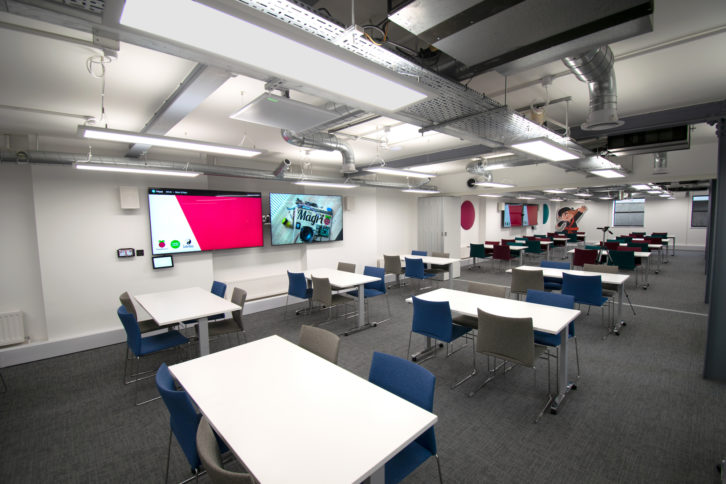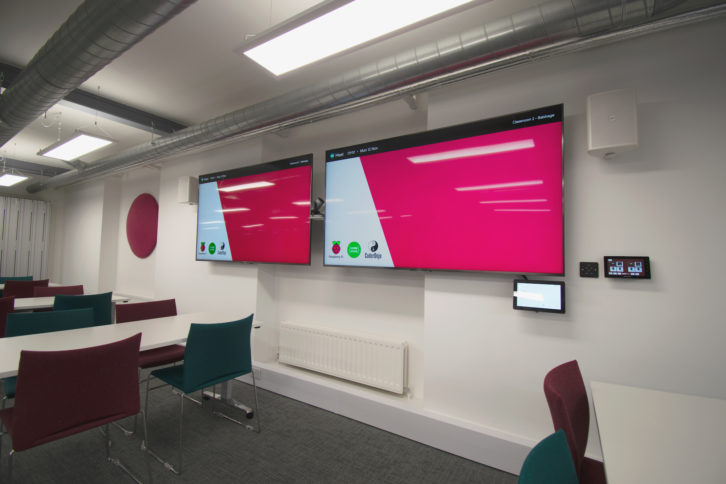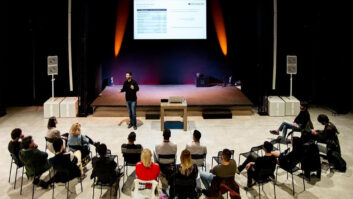
The Raspberry Pi Foundation is a UK-based charity that promotes the study of basic computer science in schools and aims to reverse the decline in the number of students applying for computer science courses at university.
The Raspberry Pi Foundation’s HQ is home to a multi-purpose divisible space, designed and developed for teamwork and collaboration, for corporate functions as well Foundation initiatives. The Foundation also supports Raspberry Jam sessions – social events held all over the world where people can come together to share their knowledge, learn new things and meet other Pi fans. Code Club is a global network of volunteers and educators who run free coding clubs for children aged 9-13 at the HQ.
Simple and robust
On the brief for the project, Steve Royans, sales director at Snelling, explains: “The brief required us to provide secure, virtual collaboration infrastructure for one large space, which is divisible into two spaces when required for small groups or to run concurrent programmes simultaneously.
“The primary use of the space is for Code Club and Raspberry Jam attended by children, which demands a simple yet robust solution. One end can be used as a boardroom for general meetings using Google Hangout hardware. Excellent audio quality was one of the prime expectations.
“The whole space functions as one large live-conferencing venue for large gatherings and all-staff meetings connecting UK and international Raspberry Pi Foundation sites.”
Additional considerations that needed to be taken into account included making certain workspaces were clean and clutter-free. “The client was specific about ensuring their workspaces are devoid of any clutter – cables, AV equipment and racks must be out of view,” says Royans. “This required us to explore new options to find solutions for the challenges this posed to us. For example, two bespoke frameworks were developed for the main displays at the divisible space. We cut into walls and fixed back into the brickwork, which allowed us to conceal all cables and fixings behind the displays and deliver a clean ‘floating’ finish.”
AV infrastructure
The divisible room is equipped to function as one large space or two independently operable spaces as required. The AV infrastructure includes four 75in Sony 4K UHD large format displays with video scaling for non-HD or 4K devices. There are custom screen and camera mounts to provide a flush, floating appearance across the alcoves.

“The client placed special emphasis on audio – the whole space functions as one large live- conferencing venue for large gatherings and all-staff meetings connecting UK and international Raspberry Pi Foundation sites,” says Royans. The audio element features separate systems for more natural sound – wall speakers for presentation sound, and ultra-wide dispersion speakers for audio conferencing. This includes two Shure MXA910W ceiling array microphones with Intellimix DSP; a QSC Q-SYS Core 110f unified services core processor; two Crestron AMP-2100 dual-channel modular power amplifiers; four TOA full range ceiling speakers; a QSC 6.5in two-way surface speaker and amplifier system; and an Audio-Technica digital wireless microphone system.
Royans explains: “The infrastructure was expected to provide secure, virtual collaboration facilities.” For the conferencing, Google Hangout NUCs with cameras and controllers are used for audio and video capture as well two Barco ClickShare wireless presentation systems and two Logitech PTZ controllers. Royans adds: “In keeping with the client’s requirement for spaces devoid of hardware clutter, the resident PC and NUCs couldn’t be located within the space itself for using Google Hangouts. In order to overcome the limitations of USB3 and to avoid a compromise on the client’s requirement, the Icron Raven USB over CAT6 extenders were deployed within the divisible space.”
To handle switching, distribution and control, Snelling specified a range of Crestron processors, switchers and transmitters as well as two branded touchscreens.
Wide audience
“The new premises welcome a wide audience including children aged 9-13 years,” says Royans. “This required us to develop a system that ‘works quietly behind the scenes.’ Walk into the new premises and you are instantly engrossed by an inspiring learning and live events space, that is minimalistic in design and yet equipped with the latest audio, visual and live conferencing facilities made available at one tap. The systems were designed to keep complexity of the AV infrastructure out of the end-user interface.
Kamila Hughes, IT manager Raspberry Pi Foundation, comments: “The service we received from Snelling was simply first class. From establishing their understanding of our requirements to the design and installation, their entire process was a testament to their experience and in-depth knowledge.
“At every stage, the exceptional staff delivered support that went above and beyond and made us feel that they were as concerned about achieving a successful outcome as we were.”
www.audio-technica.com
www.barco.com
www.cisco.com
www.crestron.eu
www.extron.com
www.icron.com
www.penn-elcom.com
www.qsc.com
www.raspberrypi.org
www.shure.com
www.snellingbiz.com
https://pro.sony
www.toaelectronics.com
www.unicol.com







